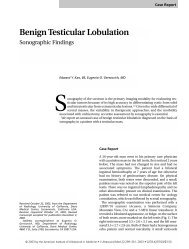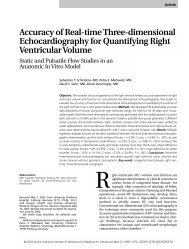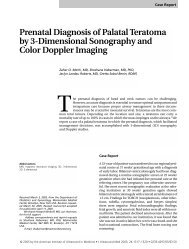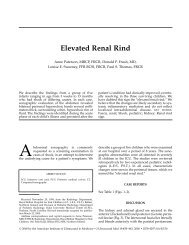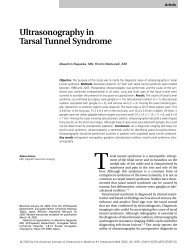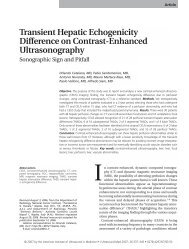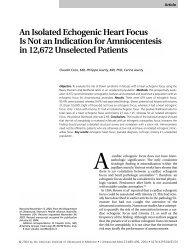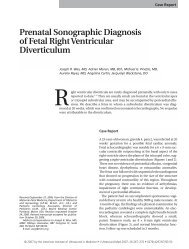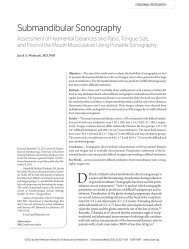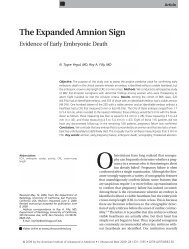Guidelines for Journal of Ultrasound in MedicineAuthors and ...
Guidelines for Journal of Ultrasound in MedicineAuthors and ...
Guidelines for Journal of Ultrasound in MedicineAuthors and ...
Create successful ePaper yourself
Turn your PDF publications into a flip-book with our unique Google optimized e-Paper software.
<strong>Guidel<strong>in</strong>es</strong> <strong>for</strong> <strong>Journal</strong> <strong>of</strong> <strong>Ultrasound</strong><br />
<strong>in</strong> Medic<strong>in</strong>e Authors <strong>and</strong> Reviewers<br />
on Measurement <strong>and</strong> Report<strong>in</strong>g<br />
<strong>of</strong> Acoustic Output <strong>and</strong> Exposure<br />
Abbreviations<br />
AIUM, American Institute <strong>of</strong> <strong>Ultrasound</strong> <strong>in</strong> Medic<strong>in</strong>e;<br />
JUM, <strong>Journal</strong> <strong>of</strong> <strong>Ultrasound</strong> <strong>in</strong> Medic<strong>in</strong>e; MI, mechanical<br />
<strong>in</strong>dex; MR, m<strong>and</strong>atory report<strong>in</strong>g; NEMA, National<br />
Electrical Manufacturers Association; ODS, Output<br />
Display St<strong>and</strong>ard; TI, thermal <strong>in</strong>dex<br />
Received December 17, 2004, from the Molecular<br />
Physics Laboratory, SRI International, Menlo Park,<br />
Cali<strong>for</strong>nia USA (P.D.E.); Department <strong>of</strong> Obstetrics<br />
<strong>and</strong> Gynecology, University <strong>of</strong> Chicago Hospital,<br />
Chicago, Ill<strong>in</strong>ois USA (J.S.A.) (now with Department<br />
<strong>of</strong> Obstetrics <strong>and</strong> Gynecology, Rush University<br />
Medical Center, Chicago, Ill<strong>in</strong>ois USA); Department<br />
<strong>of</strong> Radiology, University <strong>of</strong> Michigan, Ann Arbor,<br />
Michigan USA (P.L.C.); Rochester Center <strong>for</strong><br />
Biomedical <strong>Ultrasound</strong> <strong>and</strong> Department <strong>of</strong><br />
Electrical <strong>and</strong> Computer Eng<strong>in</strong>eer<strong>in</strong>g, University <strong>of</strong><br />
Rochester, Rochester, New York USA (E.L.C.); <strong>and</strong><br />
Siemens Medical Solutions USA, Inc, Mounta<strong>in</strong><br />
View, Cali<strong>for</strong>nia USA (K.L.S.). Revision requested<br />
December 20, 2004. Revised manuscript accepted<br />
<strong>for</strong> publication April 5, 2005.<br />
This <strong>in</strong>vited report was solicited by Deputy Editor<br />
Thomas Nelson, PhD, <strong>of</strong> the <strong>Journal</strong> <strong>of</strong> <strong>Ultrasound</strong><br />
<strong>in</strong> Medic<strong>in</strong>e (JUM) <strong>and</strong> has been reviewed by the<br />
American Institute <strong>of</strong> <strong>Ultrasound</strong> <strong>in</strong> Medic<strong>in</strong>e’s<br />
Technical St<strong>and</strong>ards <strong>and</strong> Bioeffects Committees. The<br />
op<strong>in</strong>ions expressed here<strong>in</strong> are those <strong>of</strong> the<br />
authors <strong>and</strong> not necessarily those <strong>of</strong> the members<br />
<strong>of</strong> these committees, the editors <strong>of</strong> the JUM, or<br />
the American Institute <strong>of</strong> <strong>Ultrasound</strong> <strong>in</strong> Medic<strong>in</strong>e.<br />
Mr S<strong>and</strong>strom is an employee <strong>of</strong> Siemens Medical<br />
Solutions USA, Inc, but has no commercial, proprietary,<br />
or f<strong>in</strong>ancial <strong>in</strong>terest <strong>in</strong> the subjects <strong>and</strong><br />
materials discussed here<strong>in</strong>.<br />
We are grateful <strong>for</strong> the advice <strong>of</strong> the AIUM<br />
Technical St<strong>and</strong>ards <strong>and</strong> Bioeffects Committees,<br />
both <strong>of</strong> which reviewed this article <strong>in</strong> draft, <strong>and</strong> <strong>for</strong><br />
the contributions <strong>of</strong> the JUM editors when we<br />
sought clarification <strong>of</strong> their objectives. Deputy<br />
Editor Thomas Nelson, PhD, also contributed an<br />
outl<strong>in</strong>e <strong>of</strong> the accompany<strong>in</strong>g tables. Morton Miller,<br />
PhD, contributed to the discussions that def<strong>in</strong>ed the<br />
scope <strong>of</strong> this article. We thank them both.<br />
Address correspondence to Peter D. Edmonds,<br />
PhD, Molecular Physics Laboratory, SRI International,<br />
PN-085, 333 Ravenswood Ave, Menlo Park, CA<br />
94025 USA.<br />
E-mail: edmonds_peter@yahoo.com<br />
Special Report<br />
Peter D. Edmonds, PhD, Jacques S. Abramowicz, MD,<br />
Paul L. Carson, PhD, Edw<strong>in</strong> L. Carstensen, PhD,<br />
Kurt L. S<strong>and</strong>strom, MS<br />
Objective. This report responds to a request from a deputy editor <strong>of</strong> the<br />
<strong>Journal</strong> <strong>of</strong> <strong>Ultrasound</strong> <strong>in</strong> Medic<strong>in</strong>e (JUM) <strong>for</strong> guidel<strong>in</strong>es <strong>for</strong> measurement <strong>and</strong><br />
report<strong>in</strong>g <strong>of</strong> acoustic output <strong>and</strong> exposure. The request was addressed to the<br />
American Institute <strong>of</strong> <strong>Ultrasound</strong> <strong>in</strong> Medic<strong>in</strong>e’s Technical St<strong>and</strong>ards <strong>and</strong><br />
Bioeffects Committees, which appo<strong>in</strong>ted a task group to draft a response. A<br />
basic premise <strong>of</strong> scientific report<strong>in</strong>g is the expectation that another <strong>in</strong>vestigator<br />
will wish to replicate a reported study. There<strong>for</strong>e, it is essential that all<br />
pert<strong>in</strong>ent <strong>in</strong><strong>for</strong>mation available or accessible to an <strong>in</strong>vestigator be reported.<br />
Methods <strong>and</strong> <strong>Guidel<strong>in</strong>es</strong>. Rationales <strong>and</strong> checklists are presented to draw<br />
authors’ attention to aspects <strong>of</strong> experimental design <strong>and</strong> exposimetry that<br />
require consideration <strong>in</strong> project plann<strong>in</strong>g, execution, <strong>and</strong> report<strong>in</strong>g.<br />
Checklists are presented <strong>for</strong> use <strong>in</strong> 2 dist<strong>in</strong>ct categories <strong>of</strong> activity: (1) cl<strong>in</strong>ical<br />
sett<strong>in</strong>gs <strong>in</strong> which a biophysical end po<strong>in</strong>t (bioeffect) is observed <strong>in</strong>cidentally<br />
dur<strong>in</strong>g another procedure; <strong>and</strong> (2) research projects specifically planned to<br />
<strong>in</strong>vestigate biophysical end po<strong>in</strong>ts (bioeffects). Reportable parameters <strong>for</strong> the<br />
<strong>for</strong>mer are limited to essentials, whereas those <strong>for</strong> the latter are presented <strong>in</strong><br />
detail. Certa<strong>in</strong> basic <strong>in</strong><strong>for</strong>mation is recommended as m<strong>and</strong>atory <strong>for</strong> reports<br />
<strong>in</strong> both categories; certa<strong>in</strong> additional parameters are designated as expected<br />
(at 3 levels <strong>of</strong> importance) when results <strong>of</strong> research are reported. Cl<strong>in</strong>ical<br />
<strong>in</strong>vestigators should comply with the short, first table (Table 1) <strong>and</strong> the last<br />
(Table 5) if applicable, but are encouraged to <strong>in</strong>clude additional data specified<br />
<strong>in</strong> other tables, as appropriate. Bioeffects experimenters should comply<br />
with Table 2 <strong>and</strong> such supplementary tables as are applicable to their study<br />
design. Table 3 is applicable if the study <strong>in</strong>volved animal or human subjects.<br />
Table 4 is applicable if the study was on cells or <strong>in</strong> vitro. Table 5 is applicable<br />
if contrast agents were used <strong>in</strong> the study. Conclusions. We recommend that<br />
pr<strong>in</strong>cipal authors be required to certify to the JUM editors that they have<br />
reviewed the appropriate checklists <strong>and</strong> complied with <strong>in</strong>dicated expectations.<br />
We recommend to reviewers that they consider <strong>in</strong>dividually adopt<strong>in</strong>g<br />
a m<strong>and</strong>atory requirement <strong>for</strong> report<strong>in</strong>g a basic set <strong>of</strong> parameters <strong>and</strong>/or<br />
descriptors <strong>of</strong> the equipment that are readily ascerta<strong>in</strong>able by, or should be<br />
known to, a cl<strong>in</strong>ical user. Key words: acoustic output; authors; bioeffects;<br />
exposure guidel<strong>in</strong>es; measurement; reviewers; report<strong>in</strong>g.<br />
© 2005 by the American Institute <strong>of</strong> <strong>Ultrasound</strong> <strong>in</strong> Medic<strong>in</strong>e • J <strong>Ultrasound</strong> Med 2005; 24:1171–1179 • 0278-4297/05/$3.50
<strong>Guidel<strong>in</strong>es</strong> <strong>for</strong> Measurement <strong>and</strong> Report<strong>in</strong>g <strong>of</strong> Acoustic Output <strong>and</strong> Exposure<br />
1172<br />
The editors <strong>of</strong> the <strong>Journal</strong> <strong>of</strong> <strong>Ultrasound</strong> <strong>in</strong><br />
Medic<strong>in</strong>e (JUM) are concerned about the<br />
frequent need hereto<strong>for</strong>e to revise submitted<br />
manuscripts report<strong>in</strong>g bioeffects<br />
to amplify the description <strong>of</strong> exposure methods<br />
<strong>and</strong> dosimetry. There<strong>for</strong>e, this report presents<br />
rationales <strong>and</strong> checklists to draw authors’ attention<br />
to aspects <strong>of</strong> experimental design <strong>and</strong><br />
exposimetry that require consideration <strong>in</strong> project<br />
plann<strong>in</strong>g, execution, <strong>and</strong> report<strong>in</strong>g.<br />
Checklists are presented <strong>for</strong> use <strong>in</strong> 2 dist<strong>in</strong>ct<br />
categories <strong>of</strong> activity:<br />
1. Cl<strong>in</strong>ical sett<strong>in</strong>gs <strong>in</strong> which a biophysical end<br />
po<strong>in</strong>t (bioeffect) is observed <strong>in</strong>cidentally dur<strong>in</strong>g<br />
another procedure; <strong>and</strong><br />
2. Research projects specifically planned to<br />
<strong>in</strong>vestigate biophysical end po<strong>in</strong>ts (bioeffects).<br />
Reportable parameters <strong>for</strong> the <strong>for</strong>mer are limited<br />
to essentials, whereas those <strong>for</strong> the latter are<br />
presented <strong>in</strong> as exhaustive detail as the writers<br />
could conceive. Certa<strong>in</strong> elementary parameters,<br />
such as the identity <strong>of</strong> the ultrasonic equipment<br />
used, are recommended as m<strong>and</strong>atory <strong>for</strong> reports<br />
<strong>in</strong> both categories; certa<strong>in</strong> additional parameters<br />
are designated as expected (at 3 levels <strong>of</strong> importance)<br />
when results <strong>of</strong> research are reported.<br />
For an <strong>in</strong>troduction to the subject, we recommend<br />
perusal <strong>of</strong> Zisk<strong>in</strong> <strong>and</strong> Lew<strong>in</strong>’s Ultrasonic<br />
Exposimetry, 1 particularly Chapters 1, 2 (Parts II<br />
<strong>and</strong> III), 3 (Part II), 4, 11 (Parts II <strong>and</strong> III), 12, <strong>and</strong><br />
13. Chapter 5 delves <strong>in</strong>to methods <strong>of</strong> measur<strong>in</strong>g<br />
acoustic power <strong>and</strong> acoustic pressure. Although<br />
this book is out <strong>of</strong> pr<strong>in</strong>t, it is available from<br />
some libraries (a useful website <strong>for</strong> check<strong>in</strong>g<br />
hold<strong>in</strong>gs worldwide is www.librarytechnology.<br />
org/libwebcats).<br />
In 1998 <strong>and</strong> 2003, the American Institute <strong>of</strong><br />
<strong>Ultrasound</strong> <strong>in</strong> Medic<strong>in</strong>e (AIUM) <strong>and</strong> the National<br />
Electrical Manufacturers Association (NEMA)<br />
jo<strong>in</strong>tly published editions <strong>of</strong> Acoustic Output<br />
Measurement St<strong>and</strong>ard <strong>for</strong> Diagnostic <strong>Ultrasound</strong><br />
Equipment. 2 This is a complex document, which<br />
rigorously addresses most aspects <strong>of</strong> acoustic output<br />
measurement <strong>and</strong> traceability to <strong>in</strong>ternational<br />
reference st<strong>and</strong>ards. It is suitable <strong>for</strong> those required<br />
or will<strong>in</strong>g to make a considerable <strong>in</strong>vestment <strong>in</strong><br />
equipment <strong>and</strong> staff <strong>for</strong> frequent measurements,<br />
<strong>for</strong> example, some research laboratories, test houses,<br />
manufacturers, <strong>and</strong> regulators.<br />
Cl<strong>in</strong>ical users face somewhat different situations<br />
than bioeffects <strong>in</strong>vestigators. On the one h<strong>and</strong>,<br />
manufacturers must provide <strong>in</strong><strong>for</strong>mation about the<br />
acoustic outputs <strong>of</strong> their equipment <strong>in</strong> a <strong>for</strong>m that is<br />
useful <strong>in</strong> the day-to-day cl<strong>in</strong>ical practice <strong>of</strong> the<br />
entire diagnostic ultrasound community. The thermal<br />
<strong>in</strong>dex (TI) <strong>and</strong> mechanical <strong>in</strong>dex (MI) 3 were<br />
devised <strong>and</strong> are commonly displayed on screen to<br />
give the user a simple <strong>and</strong> rapid, but crude, estimate<br />
<strong>of</strong> relative acoustic output <strong>of</strong> their equipment. On<br />
the other h<strong>and</strong>, bioeffects <strong>in</strong>vestigators use the slow<br />
process <strong>of</strong> publication to communicate to the much<br />
smaller research community the actual exposures<br />
experienced by the subjects <strong>of</strong> their experiments. In<br />
research, greater accuracy is not only achievable but<br />
also is more important than <strong>in</strong> day-to-day cl<strong>in</strong>ical<br />
activity. Furthermore, the <strong>in</strong>vestigator’s report to<br />
peers <strong>in</strong> the research community may use different<br />
language <strong>and</strong> should supply greater detail than a<br />
manufacturer provides to its customers.<br />
In pr<strong>in</strong>ciple, every experiment presents unique<br />
problems <strong>of</strong> ultrasonic dosimetry. Most bioeffects<br />
studies, however, fall <strong>in</strong>to 1 <strong>of</strong> 3 broad categories:<br />
1. Animal studies, which have yielded most<br />
bioeffects <strong>in</strong><strong>for</strong>mation that is directly useful;<br />
2. Observations <strong>of</strong> effects <strong>of</strong> ultrasound on cell<br />
preparations, which have yielded some basic<br />
knowledge; <strong>and</strong><br />
3. Pert<strong>in</strong>ent cl<strong>in</strong>ical studies, <strong>in</strong>clud<strong>in</strong>g all our<br />
epidemiologic data on the use <strong>of</strong> diagnostic<br />
ultrasound.<br />
As categories <strong>of</strong> research, each has its own<br />
dosimetry characteristics.<br />
Animal Studies<br />
The parameters <strong>of</strong> primary <strong>in</strong>terest <strong>in</strong> a bioeffects<br />
study are usually a temperature rise <strong>and</strong><br />
pressure amplitude at the specimen. These<br />
parameters have been related, respectively, to<br />
thermal <strong>and</strong> mechanical mechanisms, the two<br />
major, established effects <strong>of</strong> ultrasound <strong>in</strong> biological<br />
tissues. In pr<strong>in</strong>ciple, it should be possible<br />
to compute the temperature elevation from a<br />
complete knowledge <strong>of</strong> the acoustic <strong>and</strong> thermal<br />
parameters <strong>of</strong> the source <strong>and</strong> target. However,<br />
J <strong>Ultrasound</strong> Med 2005; 24:1171–1179
this process is so challeng<strong>in</strong>g that a direct measurement<br />
<strong>of</strong> temperature is preferable even if it<br />
is difficult. Thermocouples may be threaded<br />
through tissue to record temperature rise<br />
directly. Thermocouple measurements dur<strong>in</strong>g<br />
ultrasound exposure are subject to artifacts<br />
from viscous heat<strong>in</strong>g at the tissue-wire <strong>in</strong>terface.<br />
Errors <strong>in</strong> determ<strong>in</strong>ation <strong>of</strong> true mammalian<br />
tissue temperature that are <strong>in</strong>troduced<br />
<strong>in</strong> this way are usually m<strong>in</strong>imal if the thermocouple<br />
is small (1 m<strong>in</strong>ute).<br />
Even when the mechanism <strong>of</strong> action is<br />
assumed to be thermal, the acoustic pressures<br />
at the site <strong>of</strong> <strong>in</strong>terest <strong>in</strong> the animal as well as the<br />
physical parameters needed to compute temperature<br />
rise should be reported. The <strong>for</strong>mer is<br />
normally accomplished by a hydrophone measurement<br />
<strong>of</strong> the free-field, peak-positive <strong>and</strong><br />
-negative pressures (<strong>in</strong> megapascals) at the<br />
position to be occupied by the animal <strong>and</strong> then<br />
by estimat<strong>in</strong>g the actual pressures <strong>in</strong> the animal,<br />
us<strong>in</strong>g corrections <strong>for</strong> attenuation <strong>of</strong> the<br />
ultrasound field by the overly<strong>in</strong>g tissue.<br />
Parameters reported <strong>for</strong> the latter should<br />
<strong>in</strong>clude distance between transducer <strong>and</strong> specimen<br />
or po<strong>in</strong>t <strong>of</strong> <strong>in</strong>terest, puls<strong>in</strong>g conditions<br />
(mode, pulse repetition frequency, duty cycle,<br />
<strong>and</strong> frame rate), beam pr<strong>of</strong>ile (–6 <strong>and</strong> –12 dB<br />
beam diameter <strong>in</strong> azimuthal <strong>and</strong> elevational<br />
directions at the depth <strong>of</strong> <strong>in</strong>terest, if known, or<br />
elevational, focal depth), measured center<br />
frequency, b<strong>and</strong>width, <strong>and</strong> spatial-peak, temporalaverage<br />
<strong>in</strong>tensity. The same acoustic parameters<br />
should be reported <strong>for</strong> experiments <strong>in</strong><br />
which the mechanism <strong>of</strong> action <strong>of</strong> ultrasound is<br />
assumed to be nonthermal.<br />
In general, but particularly when the temporalpeak<br />
pressures are large <strong>and</strong> the wave<strong>for</strong>ms are<br />
distorted by nonl<strong>in</strong>ear propagation, it is useful to<br />
provide a pressure-time plot <strong>of</strong> the pulse pr<strong>of</strong>ile<br />
at the site to be occupied by the experimental<br />
animal.<br />
Justification <strong>for</strong> ignor<strong>in</strong>g heat<strong>in</strong>g <strong>in</strong> these<br />
experiments can frequently be given analytically<br />
by reference to the measured, acoustic <strong>in</strong>tensity<br />
<strong>and</strong> exposure time. 4 In borderl<strong>in</strong>e cases,<br />
however, direct, thermocouple measurements<br />
may be necessary to demonstrate that heat<strong>in</strong>g<br />
is negligible.<br />
Cell Suspensions<br />
The bioeffects literature is replete with reports<br />
<strong>of</strong> the effects result<strong>in</strong>g from ultrasonic exposures<br />
<strong>of</strong> suspensions <strong>of</strong> cells. From the st<strong>and</strong>po<strong>in</strong>t<br />
<strong>of</strong> dosimetry, there is a fundamental<br />
difference between these exposures <strong>and</strong> those<br />
experienced by the tissues <strong>of</strong> experimental animals.<br />
In animal experiments, the beam pattern<br />
<strong>of</strong> the ultrasound field conveys the <strong>in</strong><strong>for</strong>mation<br />
about the distribution <strong>of</strong> exposure to different<br />
parts <strong>of</strong> the tissue. Cell suspensions, <strong>in</strong> contrast,<br />
are cont<strong>in</strong>uously stirred dur<strong>in</strong>g exposure by<br />
acoustic stream<strong>in</strong>g. Also, st<strong>and</strong><strong>in</strong>g waves may<br />
be produced <strong>in</strong> the exposure vessel, <strong>and</strong> the distribution<br />
<strong>of</strong> cells <strong>in</strong> the exposure vessel may be<br />
affected by the st<strong>and</strong><strong>in</strong>g waves. St<strong>and</strong><strong>in</strong>g waves<br />
<strong>in</strong>troduce large gradients <strong>in</strong> the field to which<br />
the suspended cells are actually exposed. These<br />
may change the distribution <strong>of</strong> cells <strong>and</strong> bubbles<br />
<strong>in</strong> the medium, which <strong>in</strong> turn may <strong>in</strong>fluence<br />
the biological effect. There<strong>for</strong>e, <strong>in</strong> addition<br />
to the acoustic parameters recommended <strong>for</strong><br />
animal experiments, reports <strong>of</strong> experiments<br />
with cell suspensions should conta<strong>in</strong> <strong>in</strong><strong>for</strong>mation<br />
about the exposure vessel <strong>and</strong> estimates <strong>of</strong><br />
the temporal characteristics <strong>of</strong> the sound field<br />
that the cells experienced. A comprehensive<br />
review <strong>of</strong> exposure systems as well as <strong>in</strong> vitro<br />
bioeffects <strong>of</strong> <strong>in</strong>ertial cavitation is provided by<br />
Miller et al. 5<br />
A Note on the <strong>Ultrasound</strong> Indices<br />
Thermal <strong>and</strong> mechanical <strong>in</strong>dices are descriptors<br />
<strong>of</strong> the output <strong>of</strong> diagnostic ultrasound<br />
systems <strong>and</strong> are def<strong>in</strong>ed <strong>in</strong> the AIUM/NEMA<br />
Output Display St<strong>and</strong>ard (ODS). 3 In general,<br />
they are not appropriate <strong>in</strong>dicators <strong>for</strong> report<strong>in</strong>g<br />
the acoustic exposure <strong>in</strong> a bioeffects<br />
experiment. In contrast to the simple numbers<br />
that describe exposure, the def<strong>in</strong>itions <strong>of</strong><br />
the <strong>in</strong>dices are complicated <strong>and</strong> <strong>in</strong>volve<br />
mathematical models <strong>and</strong> assumptions about<br />
the propagat<strong>in</strong>g media. They differ qualitatively<br />
from the acoustic exposure parameters<br />
needed to describe exposures <strong>in</strong> bioeffects<br />
experiments.<br />
The importance <strong>of</strong> the TI <strong>and</strong> MI is to allow the<br />
operator to compare relative values <strong>of</strong> these<br />
<strong>in</strong>dices under different operat<strong>in</strong>g conditions<br />
selected <strong>in</strong> the course <strong>of</strong> an imag<strong>in</strong>g session.<br />
Edmonds et al<br />
J <strong>Ultrasound</strong> Med 2005; 24:1171–1179 1173
<strong>Guidel<strong>in</strong>es</strong> <strong>for</strong> Measurement <strong>and</strong> Report<strong>in</strong>g <strong>of</strong> Acoustic Output <strong>and</strong> Exposure<br />
1174<br />
The TI, <strong>for</strong> example, is a rough estimate <strong>of</strong> the<br />
maximum temperature <strong>in</strong>crement <strong>in</strong> the field <strong>of</strong><br />
an ultrasound source, assum<strong>in</strong>g that the transducer<br />
is <strong>in</strong> contact with a medium whose properties<br />
are those that are built <strong>in</strong>to the def<strong>in</strong>ition<br />
<strong>of</strong> the TI through the assumed model. The location<br />
<strong>of</strong> the temperature maximum <strong>in</strong> the ultrasound<br />
field is not known from the value <strong>of</strong> the TI,<br />
nor is the actual temperature rise anywhere <strong>in</strong> a<br />
specific tissue medium. For example, if the actual<br />
temperature rise at the site <strong>of</strong> <strong>in</strong>terest <strong>in</strong> an<br />
animal experiment is 1°C <strong>and</strong> the actual maximum<br />
temperature rise elsewhere <strong>in</strong> the field is<br />
3°C but the TI <strong>for</strong>mula yields an estimate <strong>of</strong> 5,<br />
the thermal exposure is 1°C but the displayed TI<br />
would be 5. If the transducer is then removed<br />
from the tissue <strong>and</strong> without other change radiates<br />
<strong>in</strong>to a water medium, temperature rises <strong>in</strong><br />
the water would be m<strong>in</strong>imal everywhere but the<br />
TI would still be 5, because the TI is a descriptor<br />
<strong>of</strong> the ultrasound system coupled to the specified<br />
tissue-equivalent medium, not an estimate <strong>of</strong> the<br />
maximum temperature rise <strong>in</strong> a different medium<br />
(ie, water). Thus, the TI is irrelevant to experiments<br />
conducted <strong>in</strong> aqueous media.<br />
A similar rationale applies to the MI. It describes<br />
certa<strong>in</strong> acoustic properties <strong>of</strong> the source, but it is<br />
not a basic exposure parameter. The use <strong>of</strong> the MI<br />
as an exposure parameter <strong>in</strong> several published<br />
reports has led to confusion <strong>and</strong> errors <strong>in</strong> the<br />
description <strong>of</strong> subject exposure.<br />
These facts <strong>in</strong> no way denigrate the output<br />
<strong>in</strong>dices. Their <strong>in</strong>corporation <strong>in</strong> st<strong>and</strong>ards <strong>and</strong><br />
their display on the screens <strong>of</strong> diagnostic ultrasound<br />
systems are as important to ultrasound<br />
safety as basic bioeffects research. The output<br />
<strong>in</strong><strong>for</strong>mation they supply is limited <strong>in</strong> quantity <strong>and</strong><br />
quality, but it comes <strong>in</strong> a <strong>for</strong>m that is suitable <strong>and</strong><br />
the best available <strong>for</strong> the concerned cl<strong>in</strong>ical user<br />
to make use <strong>of</strong> exist<strong>in</strong>g bioeffects knowledge.<br />
Cl<strong>in</strong>ical Studies<br />
At a m<strong>in</strong>imum, the acoustic output <strong>of</strong> cl<strong>in</strong>ical<br />
equipment to be used <strong>for</strong> a bioeffects study<br />
should be measured be<strong>for</strong>e <strong>and</strong> spot-checked<br />
after the study, preferably by or with the assistance<br />
<strong>of</strong> its manufacturer us<strong>in</strong>g AIUM/NEMA or<br />
International Electrotechnical Commission<br />
(IEC) st<strong>and</strong>ard methods. Researchers are encouraged<br />
to seek assistance <strong>of</strong> the manufacturer or a<br />
qualified test<strong>in</strong>g program. If test conditions were<br />
changed dur<strong>in</strong>g the study, then recalibration<br />
would be necessary after the study.<br />
Results will depend on the particular transducer<br />
assembly <strong>and</strong> equipment sett<strong>in</strong>gs used.<br />
(Note: Acoustic output data provided <strong>in</strong> manuals<br />
supplied with ultrasound diagnostic equipment<br />
may not be relevant because <strong>of</strong> the many<br />
possible comb<strong>in</strong>ations <strong>of</strong> equipment sett<strong>in</strong>gs<br />
<strong>and</strong> because transducer-to-transducer variations<br />
<strong>and</strong>, to a lesser degree, system-to-system<br />
variations can be substantial.) Results <strong>of</strong> these<br />
calibrations, specify<strong>in</strong>g the test methods <strong>and</strong><br />
equipment sett<strong>in</strong>gs used <strong>in</strong> the study, should be<br />
reported <strong>in</strong> a manuscript. Notable disadvantages<br />
<strong>of</strong> this recommended calibration procedure<br />
are loss <strong>of</strong> the use <strong>of</strong> cl<strong>in</strong>ical equipment<br />
while it is be<strong>in</strong>g calibrated <strong>and</strong> associated<br />
transportation <strong>and</strong> test costs. To m<strong>in</strong>imize<br />
these disadvantages, it may be considered adequate<br />
if only the <strong>in</strong>vestigator’s transducer<br />
assembly is calibrated <strong>and</strong> assurance is given<br />
that the equipment console has been ma<strong>in</strong>ta<strong>in</strong>ed<br />
to the manufacturer’s per<strong>for</strong>mance specifications.<br />
In all cases, essential calibration<br />
entails prediction <strong>of</strong> the ranges <strong>of</strong> equipment sett<strong>in</strong>gs<br />
that will be used <strong>in</strong> the study.<br />
Cl<strong>in</strong>ical <strong>in</strong>vestigators <strong>for</strong>tunate enough to have<br />
biophysicists or biomedical eng<strong>in</strong>eers <strong>in</strong>-house<br />
may be able to expedite calibrations by mak<strong>in</strong>g<br />
use <strong>of</strong> exist<strong>in</strong>g facilities. At a m<strong>in</strong>imum, a st<strong>and</strong>ard,<br />
calibrated hydrophone <strong>and</strong> an <strong>in</strong>strumented<br />
test<strong>in</strong>g tank are needed <strong>for</strong> such calibrations.<br />
An acoustic (radiation) <strong>for</strong>ce balance is desirable<br />
but not essential.<br />
Report<strong>in</strong>g calibrated, acoustic output power is<br />
only the first step. Exposure refers to acoustic<br />
conditions at the specimen remote from the<br />
transducer assembly. <strong>Ultrasound</strong> propagated<br />
from the transducer assembly may be diffracted,<br />
focused, absorbed, scattered, reflected, refracted,<br />
or converted to a different frequency or<br />
propagation mode be<strong>for</strong>e it reaches the specimen.<br />
Ideally, the acoustic properties <strong>of</strong> all media<br />
<strong>in</strong>terven<strong>in</strong>g between the transducer assembly<br />
<strong>and</strong> the specimen will be reported to permit calculations,<br />
if desired. Practically, it is recognized<br />
that <strong>in</strong> some cases sufficient data may not be<br />
available. Nevertheless, due diligence should be<br />
exercised to report as comprehensively as possi-<br />
J <strong>Ultrasound</strong> Med 2005; 24:1171–1179
le. In the accompany<strong>in</strong>g tables, parameters<br />
that are expected to be reported are ranked <strong>in</strong><br />
importance.<br />
With human subjects, direct measurement <strong>of</strong><br />
temperature rises <strong>and</strong> acoustic pressures <strong>in</strong> situ<br />
are normally precluded. In these experiments,<br />
the on-screen values <strong>of</strong> TI <strong>and</strong> MI may be<br />
reported, but do<strong>in</strong>g so does not relieve the<br />
<strong>in</strong>vestigators <strong>of</strong> the responsibility <strong>of</strong> comput<strong>in</strong>g<br />
the actual exposure data at the sites presumed to<br />
be affected by ultrasound exposure <strong>and</strong> report<strong>in</strong>g<br />
those values <strong>and</strong> the methods used <strong>in</strong> determ<strong>in</strong><strong>in</strong>g<br />
them.<br />
Discussion <strong>and</strong> Recommendations<br />
In all studies, the overarch<strong>in</strong>g purpose <strong>of</strong><br />
report<strong>in</strong>g exposure parameters is to enable<br />
other <strong>in</strong>vestigators to replicate studies <strong>and</strong><br />
thereby validate, supplement, or call <strong>in</strong> question<br />
published results. Reviewers bear<strong>in</strong>g this<br />
purpose <strong>in</strong> m<strong>in</strong>d may hold different op<strong>in</strong>ions<br />
on what is necessary <strong>and</strong> sufficient to ensure<br />
replicability.<br />
Authors may have complied with st<strong>and</strong>ards<br />
that specify precise methods <strong>for</strong> mak<strong>in</strong>g ultrasound<br />
field measurements, or they may have<br />
relied on documentation or cited reports; <strong>in</strong><br />
all cases, they are expected to report their<br />
sources <strong>and</strong> results. It is important <strong>for</strong> authors<br />
to review a checklist <strong>of</strong> factors that identify the<br />
equipment <strong>and</strong> determ<strong>in</strong>e the exposure to<br />
ensure that all expected or available data are<br />
<strong>in</strong>cluded <strong>in</strong> a manuscript. However, as noted<br />
above, parameters important <strong>for</strong> one type <strong>of</strong><br />
study may be unimportant <strong>for</strong> another type.<br />
The follow<strong>in</strong>g checklists (Tables 1–5) are provided<br />
<strong>in</strong> tabular <strong>for</strong>m to encourage report<strong>in</strong>g <strong>of</strong><br />
<strong>in</strong><strong>for</strong>mation that reviewers will need to evaluate<br />
manuscripts <strong>and</strong> other <strong>in</strong>vestigators will need<br />
to replicate experiments or per<strong>for</strong>m supplementary<br />
calculations.<br />
Cl<strong>in</strong>ical <strong>in</strong>vestigators should comply with the<br />
short, first table (Table 1) <strong>and</strong> the last (Table 5),<br />
if applicable, but are encouraged to <strong>in</strong>clude<br />
additional data specified <strong>in</strong> other tables, as<br />
appropriate.<br />
Bioeffects experimenters should comply<br />
with Table 2 <strong>and</strong> such supplementary tables as<br />
are applicable to their study design. Table 3 is<br />
applicable if the study <strong>in</strong>volved animal or<br />
human subjects. Table 4 is applicable if the<br />
study was on cells or <strong>in</strong> vitro. Table 5 is applicable<br />
if contrast agents were used <strong>in</strong> the study.<br />
We recommend that pr<strong>in</strong>cipal authors be<br />
required to certify to the JUM editors that they<br />
have reviewed the appropriate checklists <strong>and</strong><br />
complied with <strong>in</strong>dicated expectations.<br />
Def<strong>in</strong>itions <strong>of</strong> terms are provided <strong>in</strong> the AIUM’s<br />
Recommended <strong>Ultrasound</strong> Term<strong>in</strong>ology. 6<br />
Table 1. Checklist <strong>for</strong> Report<strong>in</strong>g OBSERVATIONS Involv<strong>in</strong>g <strong>Ultrasound</strong> Exposures <strong>of</strong> HUMAN SUBJECTS<br />
Mach<strong>in</strong>e Parameters Recommendation Unit Notes<br />
Manufacturer MR<br />
Console model MR Part number, serial number<br />
Transducer model MR Style, part number, serial number<br />
S<strong>of</strong>tware version number MR<br />
Scann<strong>in</strong>g mode <strong>and</strong> submode MR eg, B-mode, compounded, harmonic<br />
Focus<strong>in</strong>g MR Geometrical or electronic, static or dynamic<br />
Focal range MR mm<br />
Mach<strong>in</strong>e sett<strong>in</strong>gs MR Application type (eg, general, Ob, cardiac) <strong>and</strong><br />
eg, selected center frequency, velocity scale,<br />
frame rate, sector size, displayed acoustic<br />
output %, sampl<strong>in</strong>g gate size (<strong>in</strong> spectral Doppler)<br />
Displayed MI MR Per ODS, MI is def<strong>in</strong>ed only at the position <strong>of</strong><br />
maximum pulse <strong>in</strong>tensity <strong>in</strong>tegral (derated)<br />
Displayed TI MR<br />
Time <strong>of</strong> exposure MR m<strong>in</strong><br />
MI <strong>in</strong>dicates mechanical <strong>in</strong>dex; MR, m<strong>and</strong>atory report<strong>in</strong>g recommended; Ob, obstetric; <strong>and</strong> TI, thermal <strong>in</strong>dex.<br />
Edmonds et al<br />
J <strong>Ultrasound</strong> Med 2005; 24:1171–1179 1175
<strong>Guidel<strong>in</strong>es</strong> <strong>for</strong> Measurement <strong>and</strong> Report<strong>in</strong>g <strong>of</strong> Acoustic Output <strong>and</strong> Exposure<br />
1176<br />
Table 2. Checklist <strong>for</strong> Report<strong>in</strong>g EXPERIMENTS Involv<strong>in</strong>g <strong>Ultrasound</strong> Exposures (ALL STUDIES)<br />
Parameters Recommendation Unit Notes<br />
Mach<strong>in</strong>e parameters<br />
Manufacturer MR<br />
Console model MR Part number, serial number<br />
Transducer model MR Style, part number, serial number<br />
S<strong>of</strong>tware version number MR<br />
Scann<strong>in</strong>g mode <strong>and</strong> submode MR eg, B-mode, compounded, harmonic<br />
Mach<strong>in</strong>e sett<strong>in</strong>gs MR Application type (eg, general, Ob, cardiac) <strong>and</strong><br />
eg, selected center frequency, velocity scale,<br />
frame rate, sector size, displayed acoustic output<br />
%, sampl<strong>in</strong>g gate size (<strong>in</strong> spectral Doppler)<br />
Displayed MI +++ Per ODS, MI is def<strong>in</strong>ed only at the position <strong>of</strong><br />
the maximum pulse <strong>in</strong>tensity <strong>in</strong>tegral (derated)<br />
Displayed TI +++<br />
Calibration methods<br />
St<strong>and</strong>ards <strong>in</strong>voked or traceability (MR) eg, follow<strong>in</strong>g AIUM 1998 measurement st<strong>and</strong>ard<br />
or other<br />
Transducer parameters<br />
Transducer type +++ eg, s<strong>in</strong>gle disk, circular array, l<strong>in</strong>er array, multiunit<br />
rotat<strong>in</strong>g, immersed<br />
Transducer aperture shape eg, circular, rectangular<br />
Transducer aperture dimensions +++ mm eg, physical diameter, height <strong>and</strong> width <strong>of</strong> the<br />
active elements<br />
Number <strong>of</strong> elements<br />
Size <strong>of</strong> elements mm Length, width, <strong>and</strong> pitch<br />
Beam pattern Show figure<br />
Beam cross-sectional pr<strong>of</strong>ile or (+++) mm All at depth <strong>of</strong> <strong>in</strong>terest or elevational, focal depth<br />
azimuthal <strong>and</strong> elevational beam<br />
widths eg, Gaussian, Bessel<br />
If widths, –3, –6, <strong>and</strong> –12 dB<br />
Focus<strong>in</strong>g +++ Geometric or electronic, static or dynamic<br />
F-number(s) (or active dimensions)<br />
Focal length +++ mm Depth <strong>of</strong> (PII. 0 max), if measurements are made;<br />
nom<strong>in</strong>al values, if measurements are not made<br />
Depth <strong>of</strong> focus (focal zone depth ++ mm eg, 50–130 mm<br />
range)<br />
Side lobes (dB down) (++) dB Report as a negative number, eg, –30 dB<br />
Grat<strong>in</strong>g lobes (++) dB Report as a negative number, eg, –30 dB<br />
Exposure parameters<br />
Acoustic power output at (+++) mW Report estimated accuracy <strong>of</strong> acoustic power<br />
transducer (W o ) measurement<br />
Mode <strong>of</strong> operation +++ Pulse or cont<strong>in</strong>uous wave<br />
Pulse center frequency +++ MHz Nom<strong>in</strong>al values, if measurements are not made<br />
Pulse echo-response pr<strong>of</strong>ile eg, damped s<strong>in</strong>gle cycle, cont<strong>in</strong>uous wave burst<br />
(show figure)<br />
Pulse duration +++ µsec Per st<strong>and</strong>ards if measured; nom<strong>in</strong>al values, if<br />
measurements are not made<br />
Duty factor %<br />
Pulse repetition frequency +++ Hz If pulsed Doppler or color mode; nom<strong>in</strong>al values, if<br />
measurements are not made<br />
Frame rate +++ Hz If B-mode or color mode; nom<strong>in</strong>al values, if measurements<br />
are not made<br />
(cont<strong>in</strong>ued)<br />
J <strong>Ultrasound</strong> Med 2005; 24:1171–1179
Table 2. (cont<strong>in</strong>ued) Checklist <strong>for</strong> Report<strong>in</strong>g EXPERIMENTS Involv<strong>in</strong>g <strong>Ultrasound</strong> Exposures (ALL STUDIES)<br />
Parameters Recommendation Unit Notes<br />
Exposure parameters (cont<strong>in</strong>ued)<br />
Nonderated <strong>in</strong>tensity at specimen (+++) W/cm 2 , Measured <strong>in</strong> water<br />
(I SPTP , I SPTA , I SATA ) mW/cm 2<br />
Estimated attenuated <strong>in</strong>tensity (+++) W/cm 2 , Report attenuation coefficient α used <strong>in</strong> estimation<br />
<strong>and</strong> power at specimen mW/cm 2 ,<br />
(I SPTP,α , I SPTA,α , I SATA,α , W. 3 [z]) W<br />
Peak rarefactional pressure at (+++) MPa Measured <strong>in</strong> water<br />
specimen (nonderated)<br />
Estimated attenuated peak (+++) MPa Report attenuation coefficient used <strong>in</strong> estimation<br />
rarefactional pressure at specimen<br />
Peak compressional pressure at (+++) MPa Measured <strong>in</strong> water<br />
specimen (nonderated)<br />
Estimated attenuated peak compress- (+++) MPa Report attenuation coefficient used <strong>in</strong> estimation<br />
ional pressure at specimen<br />
Measurement equipment used<br />
Acoustic power equipment <strong>and</strong> ++ eg, radiation <strong>for</strong>ce balance, hydrophone raster<br />
method scan, . . .<br />
Hydrophone <strong>and</strong> amplifier ++ Which hydrophone <strong>and</strong> amplifier model <strong>and</strong> S/N<br />
used? When calibrated?<br />
Digitizer + Manufacturer, model, number <strong>of</strong> bits resolution<br />
Position<strong>in</strong>g system + eg, stepper motors, h<strong>and</strong> crank<br />
Water temperature +++ °C<br />
Exposure tank dimensions cm or m<br />
Exposure tank volume L Filled volume<br />
Exposure tank wall absorbers Manufacturer, description<br />
Exposure tank reflection coefficient dB Report as a negative number (dB down), eg, –20 dB<br />
Medium degass<strong>in</strong>g method (if water) Report if water deionized, distilled, or from tap<br />
Regass<strong>in</strong>g precautions eg, float<strong>in</strong>g polystyrene balls<br />
Experimental parameters <strong>and</strong> conditions<br />
Range from transducer to target or MR cm<br />
specimen (z)<br />
Acoustic coupl<strong>in</strong>g medium eg, gel, gel pad, degassed water<br />
Interven<strong>in</strong>g media types ++ eg, fat, muscle, bone, amniotic fluid<br />
Interven<strong>in</strong>g media thicknesses ++ mm<br />
Interven<strong>in</strong>g media boundary<br />
geometry<br />
Interven<strong>in</strong>g media speeds <strong>of</strong> sound + m/s<br />
Interven<strong>in</strong>g media acoustic impedances + Mrayl rayl = kg ⋅ m –2 ⋅ s –1<br />
Interven<strong>in</strong>g media acoustic attenuation + dB ⋅ cm –1 ⋅<br />
coefficients MHz –1<br />
Error analysis<br />
Probable r<strong>and</strong>om errors +++ Or type A<br />
Probable systematic errors +++ Or type B<br />
Support<strong>in</strong>g material<br />
L<strong>in</strong>e draw<strong>in</strong>g <strong>of</strong> experimental<br />
apparatus with dimensions<br />
Photograph <strong>of</strong> exposure <strong>in</strong> progress<br />
I SATA <strong>in</strong>dicates spatial-average, temporal-average <strong>in</strong>tensity; I SPTA , spatial-peak, temporal-average <strong>in</strong>tensity; I SPTP , spatial-peak, temporal<br />
peak <strong>in</strong>tensity; α, attenuation coefficient assumed <strong>in</strong> calculations <strong>for</strong> the acoustic path between the transducer <strong>and</strong> the<br />
specimen; MR, m<strong>and</strong>atory report<strong>in</strong>g recommended; Ob, obstetric; PII. 0 , pulse <strong>in</strong>tensity <strong>in</strong>tegral (nonderated); S/N, signal/noise<br />
ratio; <strong>and</strong> W. 3 [z], estimated attenuated power at specimen. Data reports: +++ <strong>in</strong>dicates def<strong>in</strong>itely expected; ++, highly expected;<br />
+, expected; <strong>and</strong> (. . .), report data if measurements are made per ODS or other cited st<strong>and</strong>ard; otherwise, report is optional.<br />
Edmonds et al<br />
J <strong>Ultrasound</strong> Med 2005; 24:1171–1179 1177
<strong>Guidel<strong>in</strong>es</strong> <strong>for</strong> Measurement <strong>and</strong> Report<strong>in</strong>g <strong>of</strong> Acoustic Output <strong>and</strong> Exposure<br />
1178<br />
A feature <strong>of</strong> the tables is the rank<strong>in</strong>g <strong>of</strong> parameters<br />
as “expected” (+), “highly expected” (++), <strong>and</strong><br />
“def<strong>in</strong>itely expected” (+++) to be reported.<br />
Rank<strong>in</strong>gs are based on an assessment <strong>of</strong> the<br />
value <strong>of</strong> the data to other researchers <strong>and</strong> the<br />
ease or difficulty <strong>of</strong> their determ<strong>in</strong>ation. Data <strong>for</strong><br />
all other, unranked parameters are nonetheless<br />
desirable.<br />
Table 3. SUPPLEMENTAL Checklist <strong>for</strong> Report<strong>in</strong>g EXPERIMENTS Involv<strong>in</strong>g <strong>Ultrasound</strong> Exposures (ANIMAL<br />
<strong>and</strong> HUMAN STUDIES)<br />
Parameters Recommendation Unit Notes<br />
Sk<strong>in</strong> shaved <strong>and</strong> depilated +++ Proximally/distally<br />
Distal acoustic impedance mismatch ++ Mrayl eg, air, foam, fluid, fur? rayl = kg ⋅ m –2 ⋅ s –1<br />
Tissue temperature as function <strong>of</strong> time (++) °C(s) Measured or estimated<br />
Measurement protocol +++ Describe <strong>in</strong> text<br />
Sk<strong>in</strong> temperature under transducer °C<br />
assembly<br />
Actual or average tissue types ++<br />
Tissue thicknesses mm Between transducer <strong>and</strong> focal region<br />
Tissue boundary geometry <strong>in</strong> beam<br />
path<br />
Tissue speed <strong>of</strong> sound m/s<br />
Tissue attenuation coefficient dB ⋅ cm –1 ⋅<br />
MHz –1<br />
Data reports: +++ <strong>in</strong>dicates def<strong>in</strong>itely expected; ++, highly expected; <strong>and</strong> (. . .), report data if measurements are made per<br />
ODS or other cited st<strong>and</strong>ard; otherwise, report is optional.<br />
Table 4. SUPPLEMENTAL Checklist <strong>for</strong> Report<strong>in</strong>g EXPERIMENTS Involv<strong>in</strong>g <strong>Ultrasound</strong> Exposures (CELL or<br />
IN VITRO STUDIES)<br />
Parameters Recommendation Unit Notes<br />
Chamber<br />
Chamber shape +++<br />
Chamber dimensions +++ mm<br />
Chamber commercial orig<strong>in</strong> Manufacturer’s part number<br />
Construction materials Describe <strong>in</strong> text<br />
Construction materials (density) g/cm 3<br />
Construction materials (speed <strong>of</strong> m/s<br />
sound)<br />
Chamber rotation speed +++ rpm If applicable<br />
Chamber st<strong>and</strong><strong>in</strong>g wave Describe <strong>in</strong> text<br />
assessment<br />
Suspend<strong>in</strong>g medium<br />
Suspend<strong>in</strong>g medium speed <strong>of</strong> sound +++ m/s<br />
Suspend<strong>in</strong>g medium temperature +++ °C<br />
Suspend<strong>in</strong>g medium viscosity + g ⋅ cm –1 ⋅ s –1<br />
Suspend<strong>in</strong>g medium air/gas <strong>in</strong>terface +++ Describe <strong>and</strong> quantify <strong>in</strong> text<br />
Suspend<strong>in</strong>g medium depth or volume +++ mm or mL<br />
Suspend<strong>in</strong>g medium density +++ g/cm 3<br />
Data reports: +++ <strong>in</strong>dicates def<strong>in</strong>itely expected; <strong>and</strong> +, expected.<br />
Another feature is the term m<strong>and</strong>atory report<strong>in</strong>g<br />
(MR).<br />
We recommend to reviewers that they consider<br />
<strong>in</strong>dividually adopt<strong>in</strong>g a m<strong>and</strong>atory requirement<br />
<strong>for</strong> report<strong>in</strong>g a basic set <strong>of</strong> parameters <strong>and</strong>/or<br />
descriptors <strong>of</strong> the equipment that are readily<br />
ascerta<strong>in</strong>able by, or should be known to, a cl<strong>in</strong>ical<br />
user. The f<strong>in</strong>al decision rests with the editors, <strong>of</strong><br />
course.<br />
J <strong>Ultrasound</strong> Med 2005; 24:1171–1179
Table 5. SUPPLEMENTAL Checklist <strong>for</strong> Report<strong>in</strong>g EXPERIMENTS Involv<strong>in</strong>g <strong>Ultrasound</strong> Exposures<br />
(CONTRAST AGENT STUDIES)<br />
Parameters Recommendation Unit Notes<br />
Manufacturer +++<br />
Type +++ Trade name<br />
Composition +++ Capsule material <strong>and</strong> encapsulated gas<br />
or liquid<br />
Total quantity <strong>of</strong> <strong>in</strong>jected agent +++ mm3 Concentration <strong>of</strong> <strong>in</strong>jected agent +++ #/mm3 ,<br />
Use protocol +++ mm3 /kg Describe <strong>in</strong> text, eg, <strong>in</strong>jection as bolus,<br />
speed <strong>of</strong> <strong>in</strong>jection<br />
Liquid h<strong>and</strong>l<strong>in</strong>g protocol +++ From reservoir to heart; describe <strong>in</strong> text,<br />
eg, degass<strong>in</strong>g method, residual gas<br />
(O ) content<br />
2<br />
Data reports: +++ <strong>in</strong>dicates def<strong>in</strong>itely expected.<br />
In justification <strong>of</strong> such extensive detail, we<br />
reiterate that a basic aspect <strong>of</strong> scientific<br />
report<strong>in</strong>g is the expectation that another<br />
<strong>in</strong>vestigator will wish to replicate a reported<br />
study. There<strong>for</strong>e, it is essential <strong>for</strong> all pert<strong>in</strong>ent<br />
<strong>in</strong><strong>for</strong>mation that is available or accessible to<br />
an <strong>in</strong>vestigator be reported. Our m<strong>in</strong>imum<br />
goal is to avoid <strong>in</strong>advertent omission <strong>of</strong> available<br />
or accessible <strong>in</strong><strong>for</strong>mation. Beyond that,<br />
we hope to stimulate <strong>in</strong>vestigators to give adequate<br />
consideration to the acoustic aspects <strong>of</strong><br />
their experimental design <strong>and</strong> reviewers <strong>of</strong><br />
their manuscripts to apply consistent criteria<br />
to the reports that they are evaluat<strong>in</strong>g <strong>for</strong> publication.<br />
References<br />
1. Zisk<strong>in</strong> MC, Lew<strong>in</strong> PA (eds). Ultrasonic Exposimetry.<br />
Boca Raton, FL, CRC Press; 1993.<br />
2. American Institute <strong>of</strong> <strong>Ultrasound</strong> <strong>in</strong> Medic<strong>in</strong>e.<br />
Acoustic Output Measurement St<strong>and</strong>ard <strong>for</strong><br />
Diagnostic <strong>Ultrasound</strong> Equipment. 1st ed. 2nd ed.<br />
Laurel, MD: American Institute <strong>of</strong> <strong>Ultrasound</strong> <strong>in</strong><br />
Medic<strong>in</strong>e; 1998, 2003.<br />
3. American Institute <strong>of</strong> <strong>Ultrasound</strong> <strong>in</strong> Medic<strong>in</strong>e,<br />
National Electrical Manufacturers Association.<br />
Output Display St<strong>and</strong>ard (ODS): St<strong>and</strong>ard <strong>for</strong> Real-<br />
Time Display <strong>of</strong> Thermal <strong>and</strong> Mechanical Acoustic<br />
Output Indices on Diagnostic <strong>Ultrasound</strong><br />
Equipment. Laurel, MD: American Institute <strong>of</strong><br />
<strong>Ultrasound</strong> <strong>in</strong> Medic<strong>in</strong>e; Rosslyn, VA; National<br />
Electrical Manufacturers Association; 1998.<br />
4. National Council on Radiation Protection. Exposure<br />
Criteria <strong>for</strong> Medical Diagnostic <strong>Ultrasound</strong>, I: Criteria<br />
Based on Thermal Mechanisms. Bethesda, MD:<br />
National Council on Radiation Protection; 1992.<br />
Report 113.<br />
5. Miller MW, Miller DL, Brayman AA. A review <strong>of</strong> <strong>in</strong><br />
vitro bioeffects <strong>of</strong> <strong>in</strong>ertial ultrasound cavitation from<br />
a mechanistic perspective. <strong>Ultrasound</strong> Med Biol<br />
1996; 22:1131–1154.<br />
6. American Institute <strong>of</strong> <strong>Ultrasound</strong> <strong>in</strong> Medic<strong>in</strong>e.<br />
Recommended <strong>Ultrasound</strong> Term<strong>in</strong>ology. 2nd ed.<br />
Laurel, MD: American Institute <strong>of</strong> <strong>Ultrasound</strong> <strong>in</strong><br />
Medic<strong>in</strong>e; 1997.<br />
Edmonds et al<br />
J <strong>Ultrasound</strong> Med 2005; 24:1171–1179 1179



